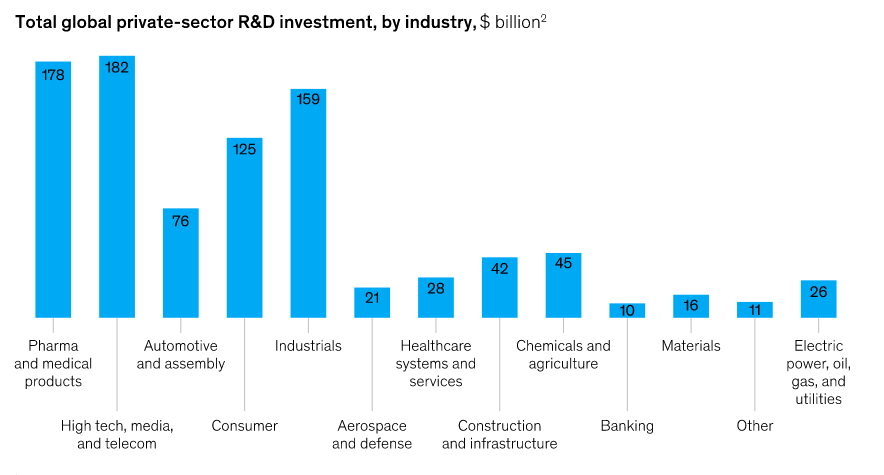The global investment in research and development (R&D) is staggering. In 2019 alone, organizations around the world spent $2.3 trillion on R&D—the equivalent of roughly 2 percent of global GDP—about half of which came from industry and the remainder from governments and academic institutions. What’s more, that annual investment has been growing at approximately 4 percent per year over the past decade.
In 2019, the pharmaceutical industry spent $83 billion dollars on R&D. Adjusted for inflation, that amount is about 10 times what the industry spent per year in the 1980s.
Between 2010 and 2019, the number of new drugs approved for sale increased by 60 percent compared with the previous decade, with a peak of 59 new drugs approved in 2018.
While the pharmaceutical sector garners much attention due to its high R&D spending as a percentage of revenues, a comparison based on industry profits shows that several industries, ranging from high tech to automotive to consumer, are putting more than 20 percent of earnings before interest, taxes, depreciation, and amortization (EBITDA) back into innovation research (Exhibit 1).
What do organizations expect to get in return? At the core, they hope their R&D investments yield the critical technology from which they can develop new products, services, and business models. But for R&D to deliver genuine value, its role must be woven centrally into the organization’s mission.
R&D should help to both deliver and shape corporate strategy, so that it develops differentiated offerings for the company’s priority markets and reveals strategic options, highlighting promising ways to reposition the business through new platforms and disruptive breakthroughs.


Choosing the ingredients of a winning R&D strategy
Given R&D’s role as the innovation driver that advances the corporate agenda, its guiding strategy needs to link board-level priorities with the technologies that are the organization’s focus. The R&D strategy must provide clarity and commitment to three central elements: what we want to deliver, what we need to deliver it, and how we will deliver it.
R&D represents a massive innovation investment, but as companies confront globalized competition, rapidly changing customer needs, and technological shifts coming from an ever-wider range of fields, they are struggling to deliver on R&D’s full potential. A clearly articulated R&D strategy that supports and informs the corporate strategy is necessary to maximize the innovation investment and long-term company value.
Yet many enterprises lack an R&D strategy that has the necessary clarity, agility, and conviction to realize the organization’s aspirations. Instead of serving as the company’s innovation engine, R&D ends up isolated from corporate priorities, disconnected from market developments, and out of sync with the speed of business. Amid a growing gap in performance between those that innovate successfully and those that do not, companies wishing to get ahead and stay ahead of competitors need a robust R&D strategy that makes the most of their innovation investments. Building such a strategy takes three steps: understanding the challenges that often work as barriers to R&D success, choosing the right ingredients for your strategy, and then pressure testing it before enacting it.
